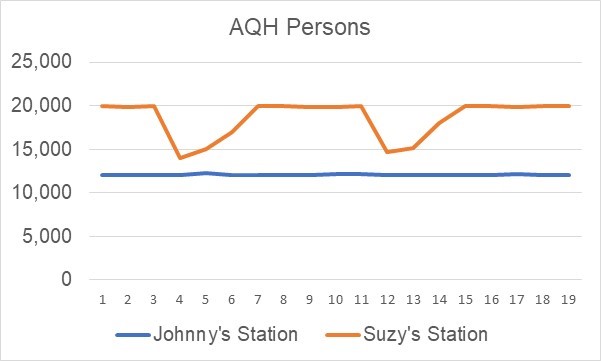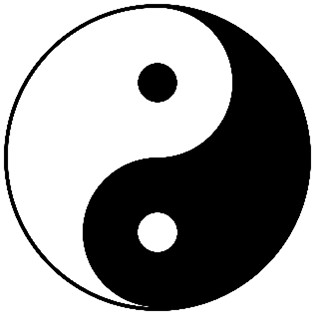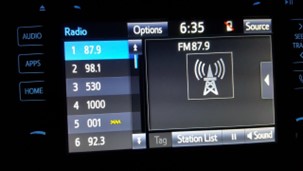Johnny’s radio station typically has 12,000 listeners in a key daypart and that audience remains stable throughout the daypart.
Suzy’s radio station has as many as 20,000 listeners in that same key daypart, but sometimes her audience falls to as few as 14,000 listeners several times during the daypart.
Whose station has a bigger AQH Persons audience for the daypart?

It’s not a trick question.
It’s also not a rhetorical question.
It’s a real-world example of the decisions many radio stations make when basing programming decisions primarily on avoiding tune-out without evaluating what factors cause listeners to tune in.
I once worked with a heritage CHR station whose ratings had consistently slid over the past 18 months. Management was dumbfounded: They were meticulously following their callout research’s Pop scores. They scrutinized M-Score. They knew they were playing the songs listeners knew, loved, and stuck around to hear. They’d seen their minute-by-minute meter counts stabilize by avoiding brand new songs and keeping the best-testing songs in power rotation. Nevertheless, those meter counts—while stable in the moment—continued slipping each month.
A perceptual study with Coleman Insights crystallized the problem: Listeners had long counted on the station to keep them up to the minute with the music scene. In just two years, however, the station’s image for playing the latest new music plummeted, replaced by a strong reputation for playing too many tired and stale songs. As more and more listeners felt the station was musically out of touch, they tuned in less and less frequently, as the station failed to live up to their expectations.
Coleman advised the station to move songs out of power categories after 26 weeks of exposure. Coleman also advised the station to give sufficient rotations to the most strategically relevant new releases, no matter how badly they first looked in callout or M-Score. Within a year, the station’s ratings rebounded while it regained its reputation for relevance.

This true tale is the paradox of playing new music.
When it debuted, PPM glaringly spotlighted the negative impact new, unfamiliar songs have on a station’s meter count in the moment. In contrast, the most well-known songs typically cause the least tune-out. Strictly looking at Popularity scores in callout research validated that, yes, songs that listeners know and love have higher scores than brand new releases that listeners have barely heard.
But when you talk to listeners in perceptual research, focus groups, or at a station event, they’ll tell you a key reason they choose a contemporary radio station is to stay up to date on the latest music. They want to know about those new songs from their favorite artists. They want to hear from new artists that are bending the trends their way.
That’s the paradox of playing new music.
The challenge is that while PPM made it easier to gauge which programming elements cause listeners to tune out in the moment, it is much less obvious to see which programming drives listeners to turn on your station in the first place.
Building tune-in occasions requires months—sometimes years—of branding through well-coordinated external marketing, promotions, and programming. It means breaking listeners’ old habits. It requires that listeners reset a preset for you. Even when ratings growth says you’re winning, you’ll often need perceptual research or focus groups to fully understand which aspects of your brand drive usage.

In contrast, tune-out only takes seconds.
It is right to avoid unnecessary tune outs, especially given the time and effort it took to get those listeners to tune in. So, what do you do when the very same programming element that causes tune-out right now also generates tune in tomorrow?
Here are four ways you can do it.
1) Have your personalities get listeners excited about new songs: Radio used to be really good at introducing listeners to new songs. Personalities would hype a new song from a core artist. They would give us the back story of a brand-new artist that piqued our interest. They would share their own excitement for brand new songs. But when PPM said we lost meters when we played those new songs, we threw out the Bubble Bath that made the bathwater inviting. Given how passionate most radio personalities are about music—especially songs they haven’t already played 1,200 times—accomplishing this goal merely requires unleashing our air talent.
2) Bet big on the songs you believe will be hits: Your gut tells you this song will be huge. But you put that new release in a low rotation category or limit it to low listenership dayparts “just to be safe.” Unfortunately, this practice keeps songs perpetually in that very state of unfamiliarity that causes tune out. A better approach is to play the song often, play it 24/7, and let listeners hear it enough to definitively embrace or reject it. Your top salesperson will tell you that the most effective advertisers on your station air their spots frequently. It takes multiple times hearing a message for it to sink in. That doesn’t happen when too much time passes since the last time they hear that message, however. Our brains work the same for songs and spots.
3) Strictly limit the number of new songs you add: Since you’ll be airing your new releases frequently, strictly limit your slots for new songs to the very few songs you most passionately believe will blow up. Not only does this practice ensure most of the songs you play are already hits, but it also means your listeners only have a couple of new songs to get to know.
4) Interpret ratings strategically: You lost some meters when you played that new song. Could that song be the reason listeners tune in next month once it’s a hit? Did the meters that left belong to the P1s who expect you to keep them up to date with the culture, or are they P3s who only tune in occasionally when their Classic Hits station is in a stopset? Is the in-tab even high enough to trust the tune-out? The most reliable way to tie ratings data to the health of your station is if your audience keeps growing quarter to quarter.
Given the dearth of sure-fire hits these last few years, the tough books for CHR stations, and young listeners rediscovering old music, it’s understandable why many traditionally contemporary stations are leaning in to proven library hits. As a lifelong radio fanatic, however, I worry that if our entire medium plays it safe today, it could cost radio its relevance tomorrow.
